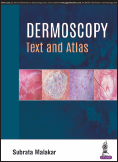Translate this page into:
Dermoscopy – Text and atlas
Correspondence Address:
Laxmisha Chandrashekar
Department of Dermatology, Jawaharlal Institute of Postgraduate Medical Education and Research, Dhanvantari Nagar, Puducherry - 605 006
India
| How to cite this article: Chandrashekar L. Dermoscopy – Text and atlas. Indian J Dermatol Venereol Leprol 2019;85:346 |

Editor: Subrata Malakar
Edition:First
ISBN: 978-93-5270-394-4
Paperback: No
Publisher: Jaypee brothers
Price: Rs. 4500
The book Dermoscopy – Text and Atlas is a multiauthor textbook and atlas on dermoscopic imaging of various conditions seen in India. There are few high-quality textbooks on dermoscopy catering to the Indian population. With the increasing popularity and utility of dermoscopy in the Indian context, such a textbook is a felt need for the Indian dermatologists.
Dr. Subrata Malakar, a senior eminent academician, has attempted to fill this void with his text and atlas of dermoscopy. He has authored and edited the book which has 20 chapters and 477 pages. The book attempts to bridge the gap between clinical examination and histology.
It starts with the basic principles and moves on to the individual conditions. The book has numerous high-quality pictures, some of them with corresponding clinical and histological pictures, which add value to the text. The essential concepts of dermoscopy are highlighted in the initial chapters on pattern recognition and interpretation of colours in a lucid manner understandable to any beginner in dermatology. The chapter on colours is well written and is one of the highlights of the book. There are two interesting chapters on “dermoscopy in a diagnostic dilemma” and “dermoscopy in therapeutic monitoring and follow up” which many clinicians will find interesting. The entire book has numerous diagrammatic representations of the dermoscopic pictures enabling even a novice to understand the various facets of the picture.
Cons include the fact that it feels more of an atlas than a text. Moreover, it would also have been better to stick to standard terminologies, unlike descriptive terms used in this atlas. It is essential to separate the features seen in a polarized from the nonpolarized mode, which has not been adequately highlighted in this text. The legends to the pictures do not carry a description of the mode of dermoscopy, which is an issue which needs to be addressed in the next edition. The readers would do well to be aware that diagnosis is established by a combination of clinical, dermoscopic features and biopsy. The audience needs to be cautious when basing a diagnosis based on some of the pictures seen in the atlas as those have not been validated in a prospective study.
To conclude, I think this book is a handy reference for beginners and established clinicians to understand the concepts in dermoscopy, especially in the Indian setting.
Fulltext Views
3,523
PDF downloads
2,767





